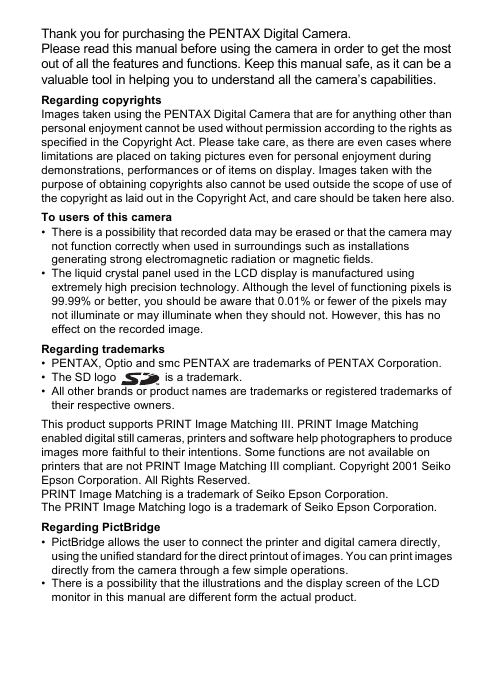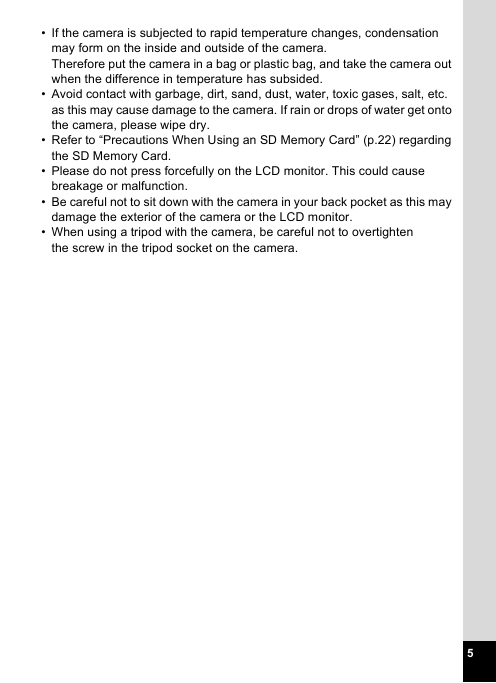Digital Camera
Operating Manual
To ensure the best performance from
your camera, please read the Operating
Manual before using the camera.
�
Thank you for purchasing the PENTAX Digital Camera.
Please read this manual before using the camera in order to get the most
out of all the features and functions. Keep this manual safe, as it can be a
valuable tool in helping you to understand all the camera’s capabilities.
Regarding copyrights
Images taken using the PENTAX Digital Camera that are for anything other than
personal enjoyment cannot be used without permission according to the rights as
specified in the Copyright Act. Please take care, as there are even cases where
limitations are placed on taking pictures even for personal enjoyment during
demonstrations, performances or of items on display. Images taken with the
purpose of obtaining copyrights also cannot be used outside the scope of use of
the copyright as laid out in the Copyright Act, and care should be taken here also.
To users of this camera
• There is a possibility that recorded data may be erased or that the camera may
not function correctly when used in surroundings such as installations
generating strong electromagnetic radiation or magnetic fields.
• The liquid crystal panel used in the LCD display is manufactured using
extremely high precision technology. Although the level of functioning pixels is
99.99% or better, you should be aware that 0.01% or fewer of the pixels may
not illuminate or may illuminate when they should not. However, this has no
effect on the recorded image.
Regarding trademarks
• PENTAX, Optio and smc PENTAX are trademarks of PENTAX Corporation.
• The SD logo
• All other brands or product names are trademarks or registered trademarks of
is a trademark.
their respective owners.
This product supports PRINT Image Matching III. PRINT Image Matching
enabled digital still cameras, printers and software help photographers to produce
images more faithful to their intentions. Some functions are not available on
printers that are not PRINT Image Matching III compliant. Copyright 2001 Seiko
Epson Corporation. All Rights Reserved.
PRINT Image Matching is a trademark of Seiko Epson Corporation.
The PRINT Image Matching logo is a trademark of Seiko Epson Corporation.
Regarding PictBridge
• PictBridge allows the user to connect the printer and digital camera directly,
using the unified standard for the direct printout of images. You can print images
directly from the camera through a few simple operations.
• There is a possibility that the illustrations and the display screen of the LCD
monitor in this manual are different form the actual product.
�
FOR SAFE USE OF YOUR CAMERA
Sufficient attention has been paid to the safety of this product but please
pay particular attention to the warnings indicated by the following
symbols during use.
Warning These symbols indicate that it is possible that the user
may experience serious difficulties if the warnings are
not heeded.
These symbols indicate that it is possible that the user
may experience minor or middling difficulties or
physical difficulties if the warnings are not heeded.
Caution
About the Camera
Warning
• Do not attempt to take the camera apart or remodel the camera. High
voltages are present within the camera, and there is therefore a danger of
electric shocks if the camera is taken apart.
• If the inside of the camera should become exposed as a result of, for
example, the camera being dropped, please do not under any
circumstances touch such exposed portions, as there is a danger of
receiving an electric shock.
• Wrapping the strap of the camera around your neck is also dangerous.
Please take care that small children do not hang the strap around their
necks.
• To avoid the risk of it being swallowed by mistake, keep the SD Memory
Card out of the reach of small children. Seek medical attention immediately
if a memory card is accidentally swallowed.
• Use an AC adapter that is of the power and voltage specified for exclusive
use with this product. The use of an AC adapter other than that specified
exclusively for use with this product may cause fire or electric shocks.
• If the camera emits smoke or a strange smell, or in the event of any other
irregularity, stop using the camera immediately, remove the battery or
disconnect the AC adapter and contact your nearest PENTAX service
center. Continued use of the camera may result in fire or electric shock.
1
�
Caution
• Never try to disassemble or short the battery. Also, do not dispose of the
battery in fire, as it may explode.
• Do not charge any batteries other than rechargeable Ni-MH batteries. The
battery could explode or catch fire. The batteries that can be used in this
camera, only the Ni-MH battery can be recharged.
• Do not place your finger on the flash when it is discharging as there is a
risk of burns.
risk of discoloring.
• Do not discharge the flash while it is touching your clothing as there is a
• If any of the battery leakage should come in contact with your eyes, do not
rub them. Flush your eyes with clean water and get medical attention
immediately.
• If any of the battery leakage should come in contact with skin or clothes,
wash the affected areas thoroughly with water.
• Remove the battery from the camera immediately if it becomes hot or
begins to smoke. Be careful not to burn yourself during removal.
• Some portions of the camera heat up during use, so please take care, as
there is a risk of low temperature burns if such portions are held for long
periods of time.
• Should the LCD be damaged, be careful of glass fragments. Also, be careful
not to allow the liquid crystal to get on your skin or in your eyes or in your
mouth.
Handling precautions for batteries
• This camera uses two AA alkaline, AA lithium, AA Ni-MH, AA nickel
manganese batteries or one CR-V3 battery. Do not use batteries other
than those specified here. Using some other type of battery may cause the
camera to function poorly, or the batteries may rupture or cause a fire.
• AA alkaline, AA lithium, AA nickel manganese and CR-V3 batteries
cannot be recharged. Do not try to take the batteries apart. The batteries
may rupture or leak if you try to charge them or take them apart.
• Do not replace the batteries with batteries that are different brands, types
or capacities. Also, do not combine old batteries with new ones. Doing so
may cause the batteries to rupture or cause a fire.
• Do not insert the batteries with the positive (+) and negative (-) poles in the
wrong orientation. Doing so may cause the batteries to rupture or cause a
fire.
2
�
About the AC Adapter
Caution
plugged in.
electrical shock.
• Do not place heavy objects on the AC plug cord, allow heavy objects to
drop onto it or allow the AC plug cord to become damaged due to
excessive bending. If the AC plug cord becomes damaged, consult a
PENTAX Service Center.
• Do not short or touch the output terminals of the product while it is still
• Do not plug in the AC plug cord with wet hands. This can cause an
• Do not subject the product to strong impacts or allow it to drop onto a hard
surface. This can cause a malfunction.
3
�
Care to be Taken During Handling
• Take the international warranty card with you when you travel abroad.
Also take the Worldwide Service Network that is included in the package.
This will be useful if you experience problems abroad.
• When the camera has not been used for a long time, confirm that it is still
working properly, particularly prior to taking important pictures (such as at
a wedding or during traveling). Contents of the recording cannot be
guaranteed if recording, playback or transferring your data to a computer,
etc. is not possible due to a malfunction of your camera or recording media
(SD Memory Card), etc.
• The lens on this camera is not exchangeable. The lens is not removable.
• Do not clean the product with organic solvents such as thinner, alcohol or
benzene.
• Places of high temperature and humidity should be avoided. Particular
care should be taken regarding vehicles, which can become very hot
inside.
• Storing the camera where pesticides and chemicals are handled should be
avoided. Remove from case and store in a well-ventilated place to prevent
the camera from becoming moldy during storage.
• Do not use the camera where it may come in contact with rain, water or any
other liquid, because the camera is not weather, water, or liquid resistant.
• Ensure that the camera is not subjected to substantial vibrations, shocks
or pressure. Place the camera on a cushion for protection when the
camera is subjected to the vibrations of a motorbike, car, or ship, etc.
• The temperature range in which the camera can be used is 0°C to
40°C (32°F to 104°F).
• The liquid crystal display will become black at high temperatures but will
return to normal when normal temperatures are returned to.
• The response speed of the liquid crystal display becomes slow at low
temperatures. This is due to the properties of the liquid crystal and is not
a fault.
• Periodic checks are recommended every 1 to 2 years in order to maintain
high performance.
4
�
• If the camera is subjected to rapid temperature changes, condensation
may form on the inside and outside of the camera.
Therefore put the camera in a bag or plastic bag, and take the camera out
when the difference in temperature has subsided.
• Avoid contact with garbage, dirt, sand, dust, water, toxic gases, salt, etc.
as this may cause damage to the camera. If rain or drops of water get onto
the camera, please wipe dry.
• Refer to “Precautions When Using an SD Memory Card” (p.22) regarding
• Be careful not to sit down with the camera in your back pocket as this may
damage the exterior of the camera or the LCD monitor.
• When using a tripod with the camera, be careful not to overtighten
the screw in the tripod socket on the camera.
• Please do not press forcefully on the LCD monitor. This could cause
the SD Memory Card.
breakage or malfunction.
5
�
Contents
Getting Started
FOR SAFE USE OF YOUR CAMERA .............................................1
Care to be Taken During Handling ...................................................4
Contents ...........................................................................................6
Contents of the Operating Manual..................................................11
Checking the Contents of the Package ..........................................12
Names of Parts...............................................................................13
Names of Operating Parts ..............................................................14
15
Attaching the Strap.............................................................................15
Powering the Camera .........................................................................16
Installing the Batteries ....................................................................16
Using the AC Adapter (optional).....................................................18
Using the AC Adapter Overseas ....................................................19
Installing the SD Memory Card..........................................................21
Recorded Pixels and Quality ..........................................................23
Turning the Camera On and Off ........................................................25
Playback Only Mode.......................................................................26
Voice Recording Only Mode...........................................................26
Initial Setting .......................................................................................27
Setting the Display Language.........................................................27
Setting the Date and Time..............................................................28
30
Taking Still Pictures............................................................................30
Playing Back Still Pictures.................................................................32
Playing Back Images ......................................................................32
Playing Back the Previous or Next Image ......................................32
Rotating the Displayed Image ........................................................33
34
Using the Button Functions...............................................................34
Capture Mode.................................................................................34
Playback Mode ...............................................................................35
Voice Recording Mode ...................................................................36
Using the Menus .................................................................................37
How to Use the Menus ...................................................................37
Example of Menu Operation...........................................................38
Enlarging a Menu Display...............................................................40
Menu List........................................................................................41
Quick Start
Common Operations
6
�
















 2023年江西萍乡中考道德与法治真题及答案.doc
2023年江西萍乡中考道德与法治真题及答案.doc 2012年重庆南川中考生物真题及答案.doc
2012年重庆南川中考生物真题及答案.doc 2013年江西师范大学地理学综合及文艺理论基础考研真题.doc
2013年江西师范大学地理学综合及文艺理论基础考研真题.doc 2020年四川甘孜小升初语文真题及答案I卷.doc
2020年四川甘孜小升初语文真题及答案I卷.doc 2020年注册岩土工程师专业基础考试真题及答案.doc
2020年注册岩土工程师专业基础考试真题及答案.doc 2023-2024学年福建省厦门市九年级上学期数学月考试题及答案.doc
2023-2024学年福建省厦门市九年级上学期数学月考试题及答案.doc 2021-2022学年辽宁省沈阳市大东区九年级上学期语文期末试题及答案.doc
2021-2022学年辽宁省沈阳市大东区九年级上学期语文期末试题及答案.doc 2022-2023学年北京东城区初三第一学期物理期末试卷及答案.doc
2022-2023学年北京东城区初三第一学期物理期末试卷及答案.doc 2018上半年江西教师资格初中地理学科知识与教学能力真题及答案.doc
2018上半年江西教师资格初中地理学科知识与教学能力真题及答案.doc 2012年河北国家公务员申论考试真题及答案-省级.doc
2012年河北国家公务员申论考试真题及答案-省级.doc 2020-2021学年江苏省扬州市江都区邵樊片九年级上学期数学第一次质量检测试题及答案.doc
2020-2021学年江苏省扬州市江都区邵樊片九年级上学期数学第一次质量检测试题及答案.doc 2022下半年黑龙江教师资格证中学综合素质真题及答案.doc
2022下半年黑龙江教师资格证中学综合素质真题及答案.doc